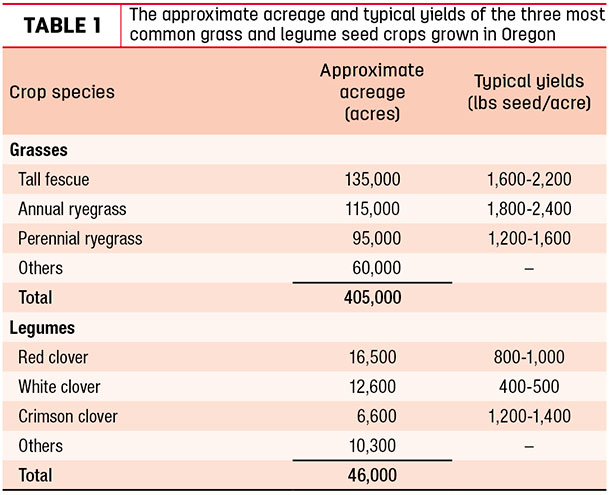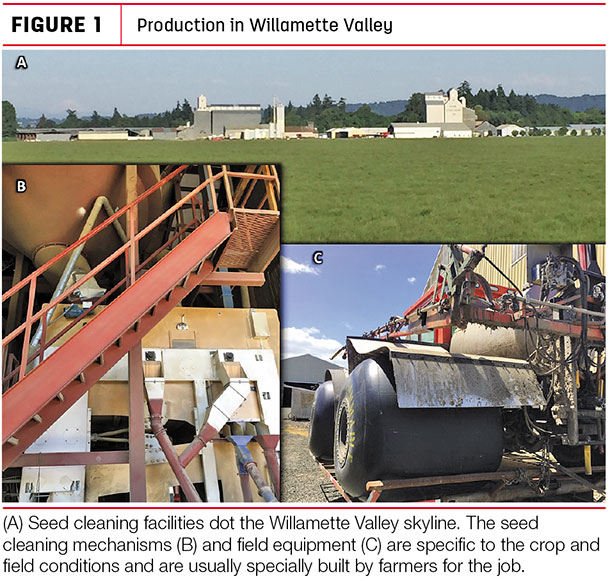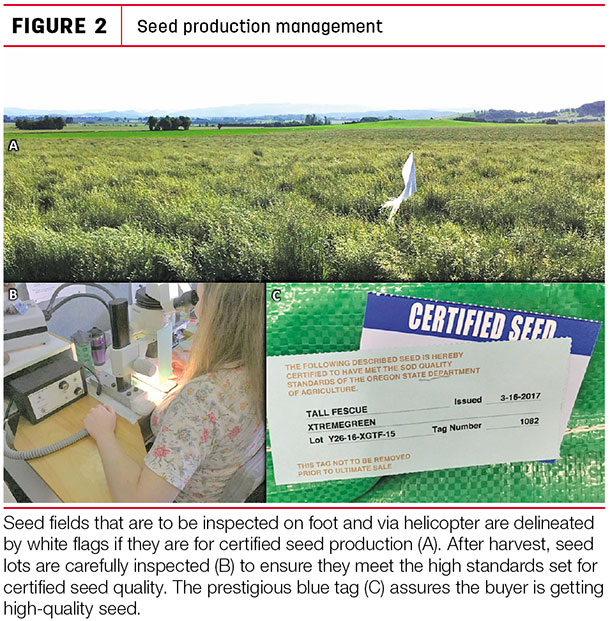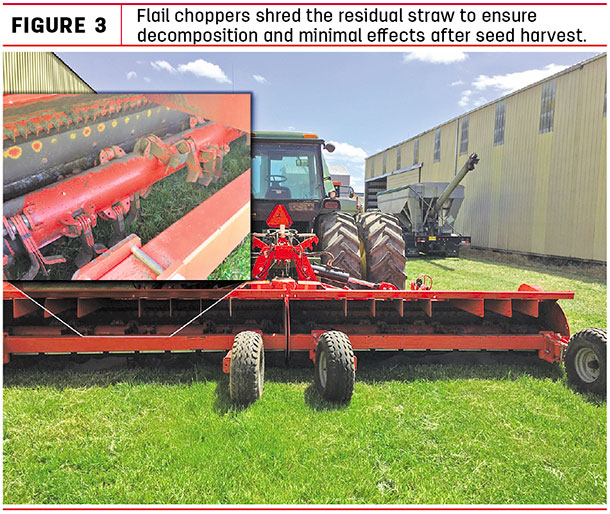Why Oregon?
The Willamette Valley is especially suited to grass and clover seed production. The last time our globe warmed, giant ice dams burst and massive flood waters raced down what is now known as the Willamette Valley. Silt and debris were deposited as it went, and deep, fertile soils were left behind.
Not long after the Oregon Trail deposited pioneers in the Willamette Valley, agriculturalists noted the area’s seed production potential. The mild, wet winters are perfect for grass growth, and its dry summers are ideal for harvest. The result is extraordinarily high seed yields (Table 1).

By the 1930s, the farms there were almost exclusively producing seed crops. Now, Oregon produces 11 species of grass crops, seven forage legume species and all major grain crops. It is also home to most of the U.S. vegetable, flower and native plant seeds, as well as being the exclusive seed producer for our domestic sugar beet industry.
These agronomic efficiencies stimulated the seed industry to bloom in the Willamette. Seed-cleaning facilities dot the landscape, nearly all of which are still owned by farm families cleaning their own seed and that of their neighbors.
Like the innovative and entrepreneurial nature found in so many rural farming communities, the specialized nature of seed production and cleaning has given rise to many unique, farmer-built pieces of equipment and devices (Figure 1).

Oregon has invested in the seed industry too. Public-private partnerships involving Oregon State University (OSU), the Oregon Department of Agriculture (ODA) and checkoff-funded commissions that promote the various seed products have also played crucial roles in fostering and sustaining the state’s seed industry. Even the regulatory environment has helped to stabilize the industry.
In the 1990s, Oregon passed “Slow Pay/No Pay” legislation that mandated seed companies pay farmers by May 1 for the seed they sold to the companies. In the 2000s, legislation enabled the formation of the Oregon Grass Seed Bargaining Association where all seed companies meet together with a council of seed growers to discuss production and set price floors under the supervision of the ODA.
This bargaining process has survived numerous challenges in federal court, where judges have held that ODA’s observation of the bargaining processes satisfies anti-collusion provisions in the Capper-Volstead Act.
By many accounts, the legislative actions have increased stability in the marketplace, improved business ethics and provided the grower with an estimated 10 cents per pound more than they would have received on the open market for their contracted acreage. Given the high inputs, lower price risks are a great advantage to the seed producer.
Seed production management
Seed production fields require intense management. For example, a typical grass seed crop may be spoon-fed up to 200 pounds of nitrogen per acre, and fungicide, herbicide and plant growth regulator applications may each occur two to four times over the course of the season. Pests and contaminants are fiercely combated to ensure quality seed.
The Oregon Seed Certification Program, a fee-based service run by OSU, examines and certifies seed fields and the lots they produce (Figure 2).

If a field is to be certified, the farmer flags the area to be included, and the seed fields are scouted on foot and by helicopter. Seed lots from these fields are then tested for quality and certification standards at the OSU Seed Laboratory.
Germination, purity, weed contamination, foreign material and other characteristics are tested against high standards for quality. If a seed lot passes, the bags are provided the blue tag synonymous with high-quality seed. Around 250,000 acres of seed fields are certified each year.
Most of these acres produce certified seed for the turf industry. The forage industry would be better off if it held more of its seed supply to such high standards.
Seed industry challenges
Like all aspects of agriculture, the Oregon seed industry faces many challenges. A primary challenge is the relatively low and stagnant seed yields of forage-type varieties. The paradox is the highest-yielding forages often produce the lowest seed yield.
If a new forage variety is ever going to make it into the marketplace, it must first produce an economical yield for the seed grower. Plant growth regulators help minimize biomass and increase seed yields by 15 to 25 percent and sometimes more, but this still may not result in economical seed yields.
Suppression of biomass production is necessary to minimize challenges to subsequent crops. Burning of crop residues was banned in the 1990s to allay air quality concerns. Now, producers must chop the residue with flails after combining (Figure 3) or bale and remove the straw.

Over 600,000 tons of grass straw is shipped overseas each year, mostly to Pacific Rim countries. Although this has provided an additional market opportunity, straw prices generally bounce around breakeven. The value of the nutrients being exported often negates profit.
Heavy crop residue loads may also cost producers in the form of greater pest pressure from slugs and voles, particularly in no-till fields. For example, many growers treat fields five or more times per year. Slug management costs have increased from a few hundred dollars per year to tens of thousands per year, and this cost must be passed on to the buyer.
The diversity of seed crops produced in this region offers many crop rotation and weed management options to the grower. But this advantage is also becoming a challenge. So many crops compete for that prized real estate that one wonders how grass and legume seed production will fare in the future.
Hazelnut orchards, vineyards and other long-term production systems now occupy land where once only grass and clover seed was produced. The growth of acres devoted to hazelnuts alone has increased to over 45,000 acres, growing by 4,300, 6,000 and more than 9,000 acres in the last three years, respectively.
Despite these challenges, seed production in the Willamette Valley will likely remain strong for the foreseeable future. Like all American farmers, the Oregon seed producers and their industry partners are dedicated to producing a high-quality product. The only difference is: They are keenly aware that other farmers’ livelihoods are dependent upon them and the quality of their product. ![]()

-
Dennis Hancock
- Associate Professor
- Extension Forage Agronomist - University of Georgia
- Email Dennis Hancock









